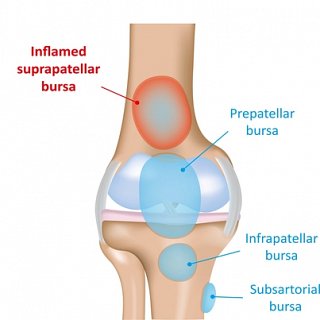Bursitis Treatment

How to treat bursitis?
We have gone through the symptoms of Bursitis - now, what do we do about treating it?
Bursitis treatment is approached in two parts. Firstly, the bursitis itself needs treatment and secondly the cause of the bursitis must be removed. Let’s look at each in turn:
-
Treatment for bursitis When you get a bursitis type inflammation then rest, ice, and physiotherapy modalities are my primary treatments of choice for bursitis flare ups. Initial treatment involves resting the joint around where the affected bursa is. Avoid putting any pressure on the bursa itself. Applying ice packs over the affected joint is also of benefit in the acute stages when there is inflammation and swelling. Ice helps reduce swelling and redness and help the bursa to return to its healthy functional state.
Generally, rest and ice will be sufficient to reduce the inflammation, but if there is no noticeable progress, then it is best to seek professional advice. The condition should be monitored closely by your doctor and chartered physiotherapist. Non-steroidal anti-inflammatory (NSAID) medication may assist also in reducing the swelling and inflammation associated with bursitis. Seek an assessment and get your doctor’s opinion before starting medication for treating your bursitis.
For some acute conditions that do not respond to rest and ice, I would often refer the patient to their doctor to consider cortisone intervention. Cortisone is a strong anti-inflammatory medication which is injected directly into the bursa having an intense but only local effect and is effective in the treatment of bursitis, especially if the swelling and pain is not responding to rest and ice.
If you have an infected bursa your bursa may need to be drained and antibiotic treatment will be required. Again, early intervention is the key, so if you suspect an infection go to your doctor immediately.
I very rarely a case that requires surgery, where the inflamed bursa is drained - and only then once all other options have been explored. In my opinion surgery is the option of last resort and should be not be considered lightly. Exhaust all other conservative treatments first is my advice!
Continued below…
Sponsored links
-
Remove the Cause of Bursitis. Treating the cause of bursitis means removing it! When I see people with bursitis at my clinic, they mostly present with pain in the hip, shoulder, elbow or knee. On further assessment they may have a muscle imbalance - some of their muscles are too weak, and others are too strong. Physiotherapy provides you with exercises to eliminate these muscle imbalances. Often it can be down to overuse of a particular limb, poor posture or poor biomechanics. Again, Physiotherapy can identify the cause and provide you with steps to take that will reduce the risk of your bursitis returning.
Identifying and addressing the underlying cause of your bursitis is best done under the guidance of a Physiotherapist. If the cause of your bursitis is repetitive working postures and movements then exercises, postural correction and taking regular breaks is the treatment of choice. A qualified ergonomic Physiotherapist will help you with overuse bursitis.
A common bursitis is in the knee. It usually occurs in people who kneel a lot for their work. Use cushions and buy a good pair of knee supports with frontal padding immediately!!! Prevention is always better than cure!
If you suffer from gout or arthritis and are prone to bursitis, try to avoid flare ups in your condition as best as you can. Consult with your doctor, rheumatologist, physio or back pain specialist to find ways of preventing flare ups.
And from feedback from some of my patients, consider alternative therapies as well as clinical medicine - as they too have their place.
Good luck!
DISCLAIMER
While the content and materials contained in the articles on this website have been written & researched by Sally Ann Quirke, a professional, practising & fully qualified Chartered Physiotherapist (Physical Therapist) based in Ireland, they are provided for general information and educational purposes only. They do not constitute medical advice on any particular individual situation. Please see your Chartered Physiotherapist or other medical practitioner for full and individual consultation.
Please read the full disclaimer here.
Cookies and Privacy
By using this website, you consent to the use of cookies in accordance with our cookie policy. For more information on how we use cookies, please read our cookie policy here.
